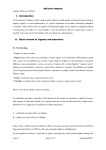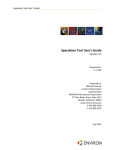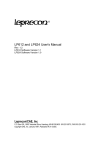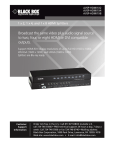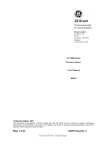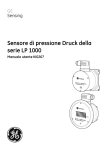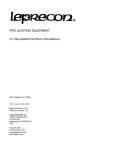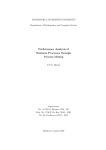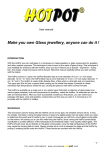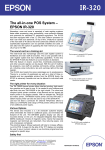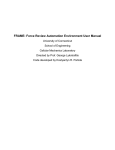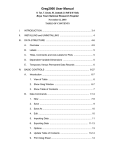Download AUX User`s Manual version 1.0 I. Introduction II. Basic
Transcript
AUX User’s Manual version 1.0
Authors: BJ Kwon, JH Park
I. Introduction
AUX stands for AUditory syntaX, used to define arbitrary sound signals and operations/processing of
auditory signals. It is semi-mathematical, i.e., signal components can be added, subtracted, multiplied
or divided. Unlike MATLAB, two signals with different lengths can be added or multiplied without
worrying about the indices or vector lengths—even the operation between a signal and a scalar is
possible. Users only need to be familiar with conventions in such operations.
II. Basic format of signals and operators
2.1. Terminology
* Vector: An array of values
* Signal: Same as the vector, but connoting a “sound” signal; AUX itself doesn’t differentiate a signal
from vector, but the different use of these words might be helpful for this document. Conceptual
difference: you conceptualize a vector as an array of values with a certain length in “sample counts;”
whereas you conceptualize a sound as a sound with a duration in “seconds.” By definition, all signals
in AUX specifications are time-bound; therefore, a duration (or sample count) is determined when you
define a signal.
* Scalar: A constant value, a special form of vector
* Variable: A variable can be used to denote or define a vector or signal and use it later.
Below, A and B are signals, a and b are scalars.
For arithmetic operations, regardless of the duration of the signals, the operation is applied as long as
each operand is valid and available. For example (note that we haven’t discussed how a signal can be
defined in AUX, signals here are defined in verbal expressions):
A = (a 500-Hz tone from 300 ms til 600ms)
B = (white noise from 500 ms til 1000ms)
Then A+B is a 500-Hz tone from 300 ms til 500 ms, the same tone plus noise from 500 ms till 600 ms,
then noise from 600 ms til 1000 ms. The same principle applies to multiplication.
For the operations between a scalar and a signal, essentially the scalar operand applies through the
Page 1 of 10
Date: March 2010
AUX User’s Manual version 1.0
Authors: BJ Kwon, JH Park
entire duration of the signal. From signal A defined above,
0.2 * A is the signal A multiplied (scaled) by 0.2 for the entire duration of the signal
0.2 + A is the signal A plus a dc-shift with the DC amplitude of 0.2.
The above explanation appears more complicated than it actually is. And this kind of convention
allows flexible application of arithmetic operations, particularly with the concept of “null signal (see
below).” If you are unsure now, please keep reading this. By the end of section 2, you will have a
clear idea about the fundamental framework of AUX. Also, in the examples below, “functions” are
used without explanations, just keep reading it, those will be covered in section 3.
2.2. Time-shift operator: >>
Shift the signal A in time forward by a milliseconds.
A >> a
Example1) tone(1000,100) is a 1000-Hz tone with 100 ms. tone(1000,100)>>500 is
the same tone but begins at 500 ms instead of 0.
2.2. RMS scaling operator: @
A @ a
Scale the signal A at a dB rms re 0 dB (full scale of the sound card)
A @ B @ a
Scale the signal A at a dB rms re 0 dB (full scale of the sound card)
Example2) Let A be a waveform read from a wave file: A = wave(“bob.wav”). Then A @ 20 specifies the signal rescaled to make its rms -20 dB re the full scale. A @ wave(“masker”)
@ 5 specifies that the
signal be adjusted its scale to its rms 5 dB above that of another signal
“masker.wav.”
2.3. Extraction operator: ~
A(a~b)
Extract a time portion between a and b millisecond from signal A. If b<a, the extracted
signal is time-reversed.
Example 3) From the signal A defined in Example 2, A(300~500) is the extracted portion of the
waveform from 300 to 500 ms. Suppose that A has a duration of 1000 ms, then A(1000~0) is a
time-reversal version of signal A.
Page 2 of 10
Date: March 2010
AUX User’s Manual version 1.0
Authors: BJ Kwon, JH Park
2.4. Playback adjustment operator: %
The % operator changes the playback rate the signal—i.e., modulating the pitch of voice and making
the duration faster or slower accordingly.
Example 4) Continuing from example 5, A%2 is the signal of the voice with the half of the pitch (with
doubled duration), and A%.5—or
A%(1/2)—is the signal of the voice with doubled pitch and half
of the duration.
2.5. Stereo signal
[A; B]
A stereo signal: A on the left channel, B on the right channel. A and B need not have the
same duration, nor they may have entirely unrelated time arrangement.
2.6. Null signal or null portion
A null signal is defined as “a signal that is not defined.” And null portion is the time portion that the
signal is not defined. As such, arithmetic operations of a null signal (or operations during the null
portion) have no effect. Note that null signal is different from a signal with zero value. For example,
in the signal defined as tone(1000,100)>>500, the signal is not defined from 0 to 500 ms. The
concept of null signal is useful to apply arithmetic operations only for partial portion of a signal.
Example 5) For ramping/damping of a signal, envelope-smoothing vector should be multiplied at the
onset and offset. With the concept of null signal, this can be easily done, as follows:
window1 = tone(25,10)*tone(25,10) // cosine-square function for increasing arc for 10-ms
window2 = window1(10~0)>>490 // mirror image in time for offset
window = window1 + window2 // defined during the onset and offset portions, null otherwise
// Finally, smoothing occurs only during onset and offset
smoothed_signal = window*original_signal
2.7. Further basics
The above example illustrates why AUX is easier than in MATLAB, because management of indices
or vector lengths is not necessary but only consideration of time in millisecond. But even easier, the
ramp function is provided in the AUX library to apply a raised cosine-square function to a signal for a
specified ramping duration. And even further, if the user needs a different type of envelope
smoothing—such as a different windowing or different times for onset and offset, etc—then a userdefined function can be prepared and used for repeated uses. In other words, the user does not need to
Page 3 of 10
Date: March 2010
AUX User’s Manual version 1.0
Authors: BJ Kwon, JH Park
write the codes in Example 5 over and over again.
Finally, many MATLAB-style expressions are also valid in AUX language. This feature was added,
first, to help seasoned MATLAB users transition to AUX easily, and second, to define and represent
any signals or processing that can be done in MATLAB. As of now, not all MATLAB expressions are
supported in AUX (probably all of them will not ever, because it is not necessary to bring the
restrictions in MATLAB to AUX). Plus, if you specify a sound from scratch as a vector, you will need
to consider all the low-level stuff such as the sampling rate, sample count, etc. See the following two
expressions that both produce the same sound in AUX:
tone(440,1000)
sin(2*3.141592*440*[1/fs:1/fs:1])
The first expression is in the original AUX-style and the second is MATLAB-style. Do you see the
difference? In AUX you don’t think about the actual implementation of the sound as the digitized
samples in the digital domain, rather you consider it as an abstract entity, “sound with certain
properties,” i.e., frequency, duration, etc. The presumption is that the issues of implementation are all
taken care of by the program that uses AUX library, not by the user. Therefore, in this AUX document,
the sampling rate is not considered or discussed at all (in realistic applications, the application should
provide some mechanisms to adjust (or set) the sampling rate to meet the demand in hand, so that the
user can set the sampling rate properly (for example, if a 15000-Hz tone is to be created, the sampling
should be greater than 3000-Hz), or if the programmer wants to fix the sampling rate at one value and
does not want to allow the user to change, at least it should notify the user if it exceeds the Nyquist
rate). However, in MATLAB language, you construct all the digitized samples from scratch and in
doing so you need to explicitly specify how digitization should occur by supplying the sampling rate
every time you define a signal.
It should also be noted that MATLAB-style expressions are supported in AUX to define or construct
vectors (true arrays of values, not actual sounds).
To summarize, the definition of signal in AUX is high-level, while the definition of signal in
MATLAB-style is low-level. It is user’s choice to use which option is proper for them. For the most
part, MATLAB-style can be avoided, or at least the repeated use of MATLAB-style expressions can
be avoided by using user-defined functions.
Here are a few MATLAB-style expressions or conventions supported in AUX that might be useful:
Page 4 of 10
Date: March 2010
AUX User’s Manual version 1.0
Authors: BJ Kwon, JH Park
i)
To define an empty vector: do this V = [ ]
Don’t be confused this with null signal.
We just need this definition to initialize an empty vector for subsequent accumulation. For
example, V = [ ] then later V = [V something_else] in a loop or something.
ii)
A vector can be defined in brackets; e.g., V = [0 20 40 60 80].
iii)
A vector can be defined by the colon (:) operator, e.g., V=0:10:1000
iv)
The colon operator works a little differently from in MATLAB, if there is only one colon.
You figure the difference from the examples below:
1:5 is equal to [1 2 3 4 5]
In AUX, 5:1 is equal to [5 4 3 2 1]
In MATLAB, 5:1 is equal to [] (empty)
In other words, if you need to define a vector [5 4 3 2 1] in AUX, you may specify
it as 5:-1:1 as you do in MATLAB, but in addition, you may do 5:1 to make it
simpler
v)
you will enjoy this simplification.
As in MATLAB, indexing is one-based.
Example 6) If x is defined as a sequence with the step of 10, from 0 to 1000, x=0:10:1000, then
x(1:2:9) indicates the following vector [0 20 40 60 80].
Example 7) Continuing from examples 2 and 3, A(22050:1) is identical to A(1000~0) in
example 3 (presuming that the sample size of A is 22050).
vi)
Cell arrays can be defined in the same ways in MATLAB using braces.
vii)
A string variable can be defined either double- or single-quotation marks: e.g., str =
“c:\soundfiles\test.wav”, wave(str)
viii)
String variables have the same rules and conventions as in MATLAB, such as
concatenating or accessing by indices.
2.8. Other conventions (full scale, order of operations)
In AUX, we shall use 1 as the full scale. And functions, tone and noise produce the sound at the full
scale (at the amplitude of 1). In the current form, AUX does not check whether the expression leads to
clipping. Therefore, it is the user’s responsibility to avoid clipping; e.g., tone(440,300) +
tone(880,300) produces clipping. A proper scaling is necessary such as 0.5*tone(440,300) +
0.5*tone(880,300)
Page 5 of 10
Date: March 2010
AUX User’s Manual version 1.0
Authors: BJ Kwon, JH Park
The following is AUX operators in the order of precedence (highest to lowest). The precedence is
pretty much standard, except for a few AUX native operators which are placed between
multiplication/division and addition/subtraction. Their associativity indicates in what order operators
of equal precedence in an expression are applied. Personally we wouldn’t memorize this, because we
think we should use parentheses whenever in doubt. But we are including this information to remind
you that there is a priority of operation when there are no parentheses, i.e., don’t presume that the
signal you defined is unambiguous to everyone (specifically, the developers of AUX ☺).
Description
Operator
Parentheses (sub-expression / function call / vector indexing)
Braces (array subscript)
+ - Unary plus/minus (sign)
!
Logical negation
^
Exponentiation
* / Multiplication/division
>>
Time shift
%
Playback speed
@
RMS
+ - Addition/subtraction
:
Range
< <= Relational less than/less than or equal to
> >= Relational greater than/greater than or equal to
== != Relational is equal to/is not equal to
&&
Logical AND
||
Logical OR
=
Assignment
( )
{ }
,
Comma (separate expressions)
Associativity
left-to-right
right-to-left
right-to-left
left-to-right
left-to-right
left-to-right
left-to-right
left-to-right
left-to-right
left-to-right
left-to-right
right-to-left
left-to-right
Example 8) tone(1000,100)>>500+20 is (tone(1000,100)>>500)+20 and is an ugly
super-duper clipped signal. You should write it as tone(1000,100)>>(500+20) if that’s what
you meant. But tone(1000,100)>>500/2 is tone(1000,100)>>(500/2), so you
should write it as (tone(1000,100)>>500)/2 if that’s what you meant.
2.9. Programming support for looping
The following syntaxes for control looping are supported, the same way as in MATLAB.
for… end
Page 6 of 10
Date: March 2010
AUX User’s Manual version 1.0
Authors: BJ Kwon, JH Park
while … end
if
[elseif] [else] end
III. Signal construction functions
tone
Generate a tone signal or tonal glide
Syntax
Arguments
tone (freq, duration, [initial_phase=0])
freq: frequency in Hz, a two-element vector of frequencies for a tone-gilde
duration: duration in msec
initial_phase: between 0 (for 0) and 1 (for 2π)
tone (226, 400)
a 226-Hz tone from 0 to 400 ms
tone (226, 400, .5) ; 226-Hz tone of 400 ms, 180 degrees out of phase
tone ([250 500], 400)
a tone glide from 250 Hz to 500 Hz
Examples
noise
Generate a white noise signal
Syntax
Arguments
noise (duration)
duration: duration in msec
fm
Generate a frequency-modulated tone signal
Syntax
Arguments
fm (freq1, freq2, mod_rate, duration, [init_phase=0])
freq1, freq2: the boundary frequencies in Hz
mod_rate: how many times the frequency will swing between freq1 and freq2,
must be a positive value
duration: duration in msec
init_phase: The initial modulation phase between 0 and 1. (0 means it begins
with freq1 and 1 means it begins with freq2)
xamples
fm(500, 700, 4, 2000)
silence
dc
gnoise
Notes
Generate a silence signal
Generate a dc signal
Generate a gaussian noise signal
The same format as noise, it takes only one argument, the duration in ms.
wave
Read a wav file
Syntax
Arguments
wave (wave_name)
wave_name: name of wave file. Use double-quotation marks, or a string variable.
a 2 second FM tone between 500 and 700 Hz at 4 Hz
If path is not included, current folder (the same directory as the psycon.exe
will be searched). The extension “.wav” can be omitted.
Examples
wave (“c:\soundData\specialnoise”)
file
Read from text (ascii) file, the values will be read into an array, delimited by a
space, CR, LF or tab character.
Syntax
file (file_name)
Read the signal from specialnoise.wav in the specified directory.
Page 7 of 10
Date: March 2010
AUX User’s Manual version 1.0
Authors: BJ Kwon, JH Park
Arguments
file_name: name of text file. Use double-quotation marks, or a string variable.
If path is not included, current folder (the same directory as the psycon.exe
will be searched). The extension “.txt” can be omitted.
IV. Signal modification functions
am
Amplitude-Modulate the signal
Syntax
Arguments
am(signal, mod_rate, [mod_depth=1], [init_phase=0])
mod_rate: AM modulation rate in Hz
mod_depth: Modulation depth between 0 (no mod) and 1 (full mod), If skipped,
full modulation is assumed.
Examples
init_phase: The initial modulation phase between 0 and 1.
am(noise(1000), 8, 0.5)
lpf
hpf
bpf
bsf
IIR filtering. Lowpass, highpass, bandpass, and bandstop filtering, respectively. lpf
and hpf require at least 2 arguments (signal and edge frequency) and bpf and bsf
require at least 3 arguments (signal and two edge frequencies). The rest arguments
are optional and available for tweaking detailed filter settings.
Syntax
lpf(signal, freq, [order=8], [kind=1], [dBpass=.5],[dBstop=-40])
hpf(signal, freq, [order=8], [kind=1], [dBpass=.5],[dBstop=-40])
bpf(signal, freq1, freq2, [order=8], [kind=1], [dBpass=.5],
[dBstop=-40])
bsf(signal, freq1, freq2, [order=8], [kind=1], [dBpass=.5],
[dBstop=-40])
order: Filter order. Default=8.
kind: 1 for Butterworth (default), 2 for Chebyshev and 3 for Elliptic
dBpass: Passband ripple in dB (default = 0.5 dB).
dBstop: Stopband attenutation in dB (default = -40 dB).
lpf(noise(1000), 2000)
Arguments
Examples
AM of a white noise at 8 Hz with a depth of 0.5
Lowpass noise with a cutoff frequency of 2000 Hz (8th order Butterworth)
hpf(noise(1000), 3000, 6, 2)
Highpass noise with a cut of 3000 Hz, 6th order Chebyshev
bpf(noise(1000), 1900, 2000, 6, 3, 1, -80)
note
bandpass noise between 1900 and 2000 Hz, 6th order Elliptic with 1dB
ripple and -60 dB attenuation
Be sure to check the IIR filter’s stability. Note that some filtering specs (such as
very narrow bandpass filtering) will be difficult to obtain stable filter coefficient.
filt
Filter the signal with the specified coefficients
Syntax
filt(signal, num_array, den_array)
filt(signal, mat_file, matlab_filter_variable)
num_array, den_array: Numerator or denominator coefficient arrays. Must
Arguments
use a bracket or tag (see how to use tag).
mat_file: The matlab file (*.mat) that contains the variable specified in the 3rd
argument. Must use double-quotation marks. This could include a path.
Default extension is .mat.
matlab_filter_variable: The matlab variable of filter coefficient generated
by sptool. Must use double-quotation marks.
Examples
filt(noise(1000), [.2 -0.2 .001], [1 -.2 .02])
Filter the white noise with these coefficient arrays (2nd order IIR)
Page 8 of 10
Date: March 2010
AUX User’s Manual version 1.0
Authors: BJ Kwon, JH Park
filt(noise(1000), “filters”, “lp1500”)
Filter the noise with the coefficients available in matlab variable lp1500
stored in filters.mat
filtfilt
Anti-causal (zero-delay) filter the signal with the specified coefficients
Syntax
filtfilt(signal, num_array, den_array)
filtfilt(signal, mat_file, matlab_filter_variable)
ramp
Make the beginning and ending points smooth (to avoid spectrum splatter)
Syntax
Arguments
ramp(signal, ramping_time)
ramping_time: The time in ms for ramping up (at the beginning) and down (at
Examples
ramp(tone(1500,500), 10)
the end)
Note
Make the tone with 10-ms beginning and ending ramping.
This uses the cosine-square function for smoothing.
V. Computation functions or functions retrieving properties of a
signal
If you want to use a dB factor for scaling, the following db function comes in handy.
Calculate the actual factor from a dB value
db
db(db_value)
Syntax
Arguments db_value: the scale factor of the specified value in dB
Examples
The following expressions are the same:
db(-6) * tone (300,500) == 0.5 * tone (300,500)
tone (300*db(6), 500) ==
tone (600, 500)
am(noise(1000), 8, db(-20)) == am(noise(1000), 8, 0.01) (-20
dB Amplitude Modulation)
rms
Compute the rms value in dB
Syntax
Arguments
rms(signal)
signal: any valid signal
dur
Get the duration of signal in ms
Syntax
dur(signal)
rand
Generates a double-precision random number
Syntax
Note
rand(max_val)
Double-precision random number between 0 and max_val (with a uniform
distribution)
irand
Generates an integer random number
Syntax
Note
irand(max_val)
Integer random number between 1 and max_val (with a uniform distribution)
randperm Generates a randomly permuted array from 1 to val
Syntax
Note
randperm(val)
An integer array from 1 to val and its order is randomly permuted is generated.
Page 9 of 10
Date: March 2010
AUX User’s Manual version 1.0
Authors: BJ Kwon, JH Park
tbegin
tend
mean
max, min
Get the beginning time in ms (first time point where the signal is non-null)
Get the ending time in ms (last time point where the signal is non-null)
Get the mean value of signal
Get the maximum (or minimum) value of the signal
Syntax
tbegin(signal)
max(signal)
tend(signal)
mean(signal)
min(signal)
Also the following functions are available for numerical calculation.
Sine
sin
Cosine
cos
Natural log
log
10-base log
log10
Absolute value
abs
Exponential
exp
a^b (a raised by b)
^
Sqrt root
sqrt
Modulo
mod
VI. User-defined function
Users may make their own functions—if you don’t like the functions that are provided, you can
override them. It needs to be saved with the extension of *.aux and accessible by the program. It has
the following format (similar to MATLAB):
function [output1, output2,…] = function_name (input1, input2,…)
…
Main
body
of
the
function—that
prepares
and
specifies
output
variables as results
Similar to MATLAB, the function keyword declared in the top of the file is visible to the program.
If there are more functions defined in the middle of the file using the same function keyword,
these are only accessible within the file (i.e., local functions).
Page 10 of 10
Date: March 2010











